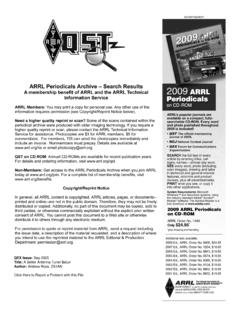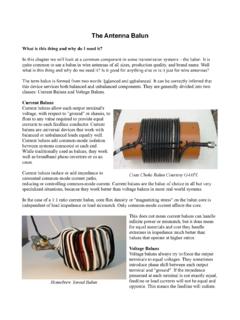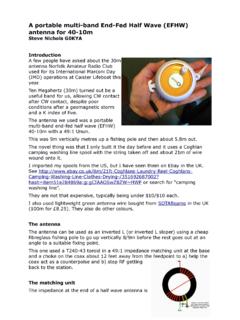Transcription of Introduction Ideal Choke - Karinya
1 IntroductionBaluns can be difficult components to analyse and understand fully; however it's possible to get a good basicunderstanding of how they operate by treating them as combinations of idealised common-mode RF paper uses that method to explore the advantages and disadvantages of some of the common baluns used by Radio ChokeThe schematic of a typical Choke is shown in Drawing 1. The Choke comprisestwo windings a-c and b-d that have the same number of turns and share acommon flux path. Typically the windings will comprise a bifilar pair or a length ofcoaxial cable; in the case of coax, a-c might be the centre conductor and b-dthe braid. The Choke is used in transmission line mode - in other words a signalis applied between terminals a-b and appears as an output at terminals Ideal Choke will have the following properties: P1: It is lossless, and the winding length is very small compared to a wavelength, so Vcd=Vab. We will refer to this as the Differential-Mode voltage applied to the Choke .
2 P2: Because the windings are identical and share the same flux, Vac=Vbd. We refer to this as the Common-Mode voltage across the Choke . P3: The Choke is assumed to have infinite Common-Mode impedance, so the Common-Mode currentmust be zero no matter how high the Common-Mode voltage is; so Iac-Idb=0 or Iac=IdbOf course no real-world Choke is Ideal , but using these properties we can easily gain useful insight into how the various balun types LoadEach balun 's operation will be discussed working into the load shown in Drawing 2. Theload has two terminals - labelled 1 & 2 - which could represent, for example, theconnections to a dipole or a beam at its feedpoint; or they might represent theconnections to a length of ladderline feeding a doublet the vast majority of Amateur applications we want to balance the currents I1 and I2flowing into and out of the load. For example, balancing those currents in a beamantenna helps preserve the radiation pattern; and balancing the currents in ladderlineminimises radiation from the line during transmissions and noise pick-up , all real-world antenna systems are actually 3-terminal loads - the third terminalbeing ground, as shown in the drawing.
3 The primary load components are Z1 & Z2, but theinclusion of Z3 provides a path for common-mode current to ground. Clearly, if we do notinclude the path to ground through Z3, currents I1 and I2 must be equal, and there is then no need for a balun !Using Ohm's Law the load's electrical properties properties are related by: I1 = (V1-V3) / Z1 I2 = (V3-V2) / Z2 I3 = V3 / Z3 I3 = I1 - I2 Note that, if the load currents I1 and I2 are balanced, I3 must be zero and V3 must be general, impedances Z1, Z2 and Z3 are complex quantities- in other words they have reactance as well as resistance. Z3 can be anything from a few Ohms to many thousands of Ohms depending on the particular system. If Z1 = Z2 the load is said to be February 2015 Drawing 1: Ideal ChokeVacabcdabcdIacIdbVbdVabVcdDrawing 2: Test Load12I1I2I3V1V2Z1Z2Z3V3(I1-I2)A) 1:1 Guanella (current) BalunDrawing 3 shows an unbalanced RF source connected to the Test Load through a 1:1 Guanella balun - identical to a simple Common Mode Choke .
4 Analysis Load currents I1 and I2 must be equal, to satisfy property P3 (Iac = Idb) Therefore I3 = 0 and V3 = 0 Voltage between load terminals (V1-V2) must equal Vin to satisfy Choke property P1 (Vcd = Vab) Common-mode voltage (stress) across the Choke Vcm = -V2 Input impedance seen by the source = Vin/I1=(Z1+Z2)Characteristics: This balun drives balanced load currents despite the load impedances being unbalanced Differing degrees of load imbalance lead to differing levels of common-mode voltage across the Choke With a perfectly balanced load (Z1 = Z2), the Choke common-mode voltage Vcm will be Vin / 2G3 TXQ February 2015 Drawing 3: 1:1 Guanella (current) BalunbdV3=012I2=I1I3=0V1V2Z1Z2Z3 Vcm = -V2I2 VinacI1=I2I1 VinB) 1:1 Voltage BalunDrawing 4 shows our unbalanced RF source connected to the load through a 1:1 voltage balun . The important feature of this balun is that a third (tertiary) winding (c-b) has been added to the Choke with the winding sense indicated by the black dots.
5 It has the same number of turns as the existing windingsThis introduces new properties to the Choke , such that now: P4: Because all three windings share the same flux Vac = Vbd = Vcb P5: Because the net common-mode current must be zero Idb = (Iac+Icb)This new property P5 has a significant effect on the operation of the balun , as we shall By inspection, (Vac + Vcb) = Vin But from P4: Vac = Vcb therefore Vac = Vcb = Vbd = Vin/2 By inspection: V1 = (Vin - Vac) = +Vin/2 By inspection: V2 = (0 - Vbd) = -Vin/2 By inspection: Idb = I2 Therefore from P5: (Iac + Icb) = I2 or Icb = (I2 - Iac) Applying Kirchoff's current law at terminal c: Iac = (I1+Icb) = (I1 + I2 - Iac) Therefore Iac = (I1+I2)/2 and tertiary winding current Icb = (I2-I1)/2 Input impedance seen by the source = / (I1+I2)Characteristics: This balun drives balanced voltages of +Vin/2 and -Vin/2 at the load terminals. Only with a perfectly balanced load will the load currents be balanced; any load imbalance will result in a corresponding current imbalance.
6 The Choke common-mode voltage is always Vin/2 and so the common-mode stress on the Choke is independent of the degree of load imbalance Any common-mode current at the load is accommodated by a related current flow through the tertiary winding; with a completely balanced load, the tertiary winding current will be zero. For most load conditions, the tertiary winding handles a much lower current than the two other windings; it is therefore often constructed with thinner gauge February 2015 Drawing 4: 1:1 Voltage balun (I1-I2)VinabcdVcm=Vin/212I1I2I3V1 = +Vin/2V2 = -Vin/2Z1Z2Z3(I1+I2)/2(I2 - I1)/2( - I1)/2(I1 - I2)(I1+I2)/2V3C) 4:1 Ruthroff (voltage) BalunDrawing 5 shows the unbalanced RF source connected to the load through a 4:1 Ruthroff voltage balun . Theschematic of the balun may look unfamiliar, but it is electrically identical to the more usual layout, and more clearly illustrates how the balun source voltage is connected directly to one load terminal (1).
7 The same source voltage is also connectedacross the input of the Choke (a-b). The Choke produces an identical voltage at its output (c-d), but one whichis isolated from its input; this isolation means that either of its output terminals can be grounded with impunity. By grounding Choke terminal c we generate an inverted copy of the input voltage at terminal d, and this is applied to the other load terminal (2). In this way we develop twice the source voltage across the load, as required for a 4:1 Load terminal voltage V1 must be +Vin because it is connected directly to the source The Choke input is connected directly across the source, therefore Vab = Vin From property P1: Vcd = Vab = Vin Because Choke terminal c is grounded, Vd = V2 = -Vin By inspection, Choke common-mode voltage Vcm = Vin By inspection: Idb = I2 Therefore from property P3: Iac = I2 Applying Kirchoff's current law, the output current from the generator = (I1+I2) Therefore, the impedance seen by the source = Vin / (I1+I2)Characteristics: This balun drives balanced voltages of +Vin and -Vin at the load terminals.
8 Only with a perfectly balanced load will the load currents be balanced; any load imbalance will result in a corresponding current imbalance. The Choke common-mode voltage is always Vin and so the common-mode stress on the Choke is independent of the degree of load imbalance Although we have assumed an Ideal Choke where Vcd=Vab, in practice there will be a phase difference between the two voltages caused by the delay in the transmission line forming the Choke winding; this causes a phase difference between the load terminal voltages V1 & V2. The phase difference increases with frequency and limits the SWR bandwidth of this type of February 2015 Drawing 5: 4:1 Ruthroff (voltage) balunV3 VinabcdVcm=Vin12I1I2I3V1= +VinV2= -VinZ1Z2Z3I2I1(I1-I2)I1(I1+I2)G3 TXQI2I2 Vcm=VinD) 4:1 Guanella (current) BalunDrawing 6 shows the unbalanced RF source connected to the load through a 4:1 Guanella current balun . The balun comprises two chokes - terminals on the lower Choke are distinguished by the ' symbol.
9 The input of each Choke is connected directly in parallel with the source. Because each Choke effectively isolates its output from its input, we can connect their outputs in series - thereby generating a voltage across the load of twice the source voltage, as required for a 4:1 By inspection: Ica=I1 Therefore from property P3: Ibd = Ica = I1 By inspection: Id'b'=I2 Therefore from property P3: Ia'c' = Id'b' = I2 But Ia'c' = Ibd because the Choke windings are connected in series; therefore I1=I2 and I3=0 By inspection: Vcd=Vin and Va'b'=Vin Therefore from property P1: Vab = Vcd = Vin and Vc'd' = Va'b' = Vin By inspection: V12 = Vab + Vc'd' Therefore differential load voltage V12 = From Ohm's Law: I1 = I2 = / (Z1+Z2) From Kirchoff's current law, output current from the source (Ica + Ia'c') = (I1 + I2) = or By inspection, lower Choke common-mode voltage Vcm' = -V2 By inspection, upper Choke common-mode voltage Vcm = (V1-Vin) By inspection: Vcm+Vcm'=Vin Impedance seen by the source = Vin/(I1+I2) = Vin /( (Z1+Z2)) = (Z1+Z2)/4 Characteristics: This balun drives balanced load currents despite the load being unbalanced The input impedance is equal to (Z1+Z2)/4 whatever the load imbalance The common-mode voltages across the two chokes - a measure of stress on the Choke - always sum to Vin.
10 However they are unequal - in fact with a perfectly-balanced load the common-mode voltage across the upper Choke is zero, and that across the lower Choke is equal to the input voltage! With some types of load imbalance, reversing the balun output terminals can reduce the common-mode voltage February 2015 Drawing 6: 4:1 Guanella (current) balun (I1-I2)bda'b'c'd'V3=012I2=I1I3=0V1V 2Z1Z2Z3 VcmI1I2 Vcm'Vcm + Vcm'=VinVinI1=I2acI1=I2(I1+I2) ) 4:1 Guanella (current) balun - single coreWe continue to see designs - both Commercial and home-made - where the two chokes forming a 4:1 Guanella balun have been wound on a common core. This is indicated in Drawing 7 by the common core lines; the winding senses are indicated by the dots .Because all 4 Choke windings now share the same flux, we get a new set of properties: P6: Vcm = Vcm' = Vac = Vbd = Va'c' = Vb'd' P7: (Ica+Id'b') = (Ia'c'+Ibd)Analysis By inspection: Va'c' + Vbd = Vin (as before) But from property P6, Va'c' must equal Vbd, so Va'c' = Vdb = Vin/2 Therefore Vcm = V'cm = Vac = Vbd = Va'c' = Vb'd' = Vin/2 Thereby driving the load terminal voltages to V1 = and V2 = -Vin/2 From property P7, (I1+I2) = (Ia'c'+Ibd) But because they are connected in series, Ia'c' = Ibd Therefore Ia'c' = Ibd = (I1+I2)/2 From Kirchoff's current law, source current is (Ica+Ia'c') = (I1+(I1+I2)/2) = ( +I2)/2 Impedance seen by the source = Vin/( +I2)/2 = ( +I2)Characteristics: This type of balun must always drive its output voltages to + and - Vin/2 with respect to ground, whatever the load These unbalanced terminal voltages drive a large load current imbalance in most loads, even one which is perfectly balanced.






